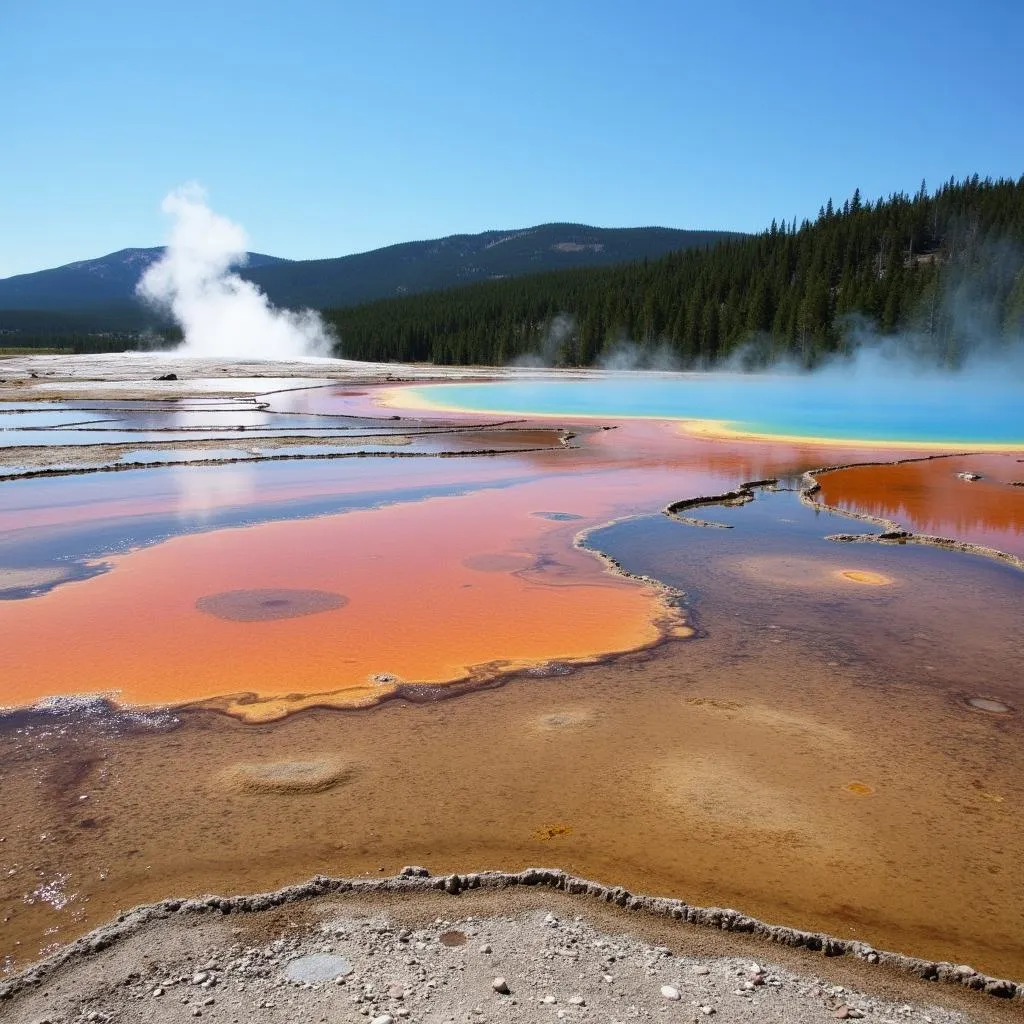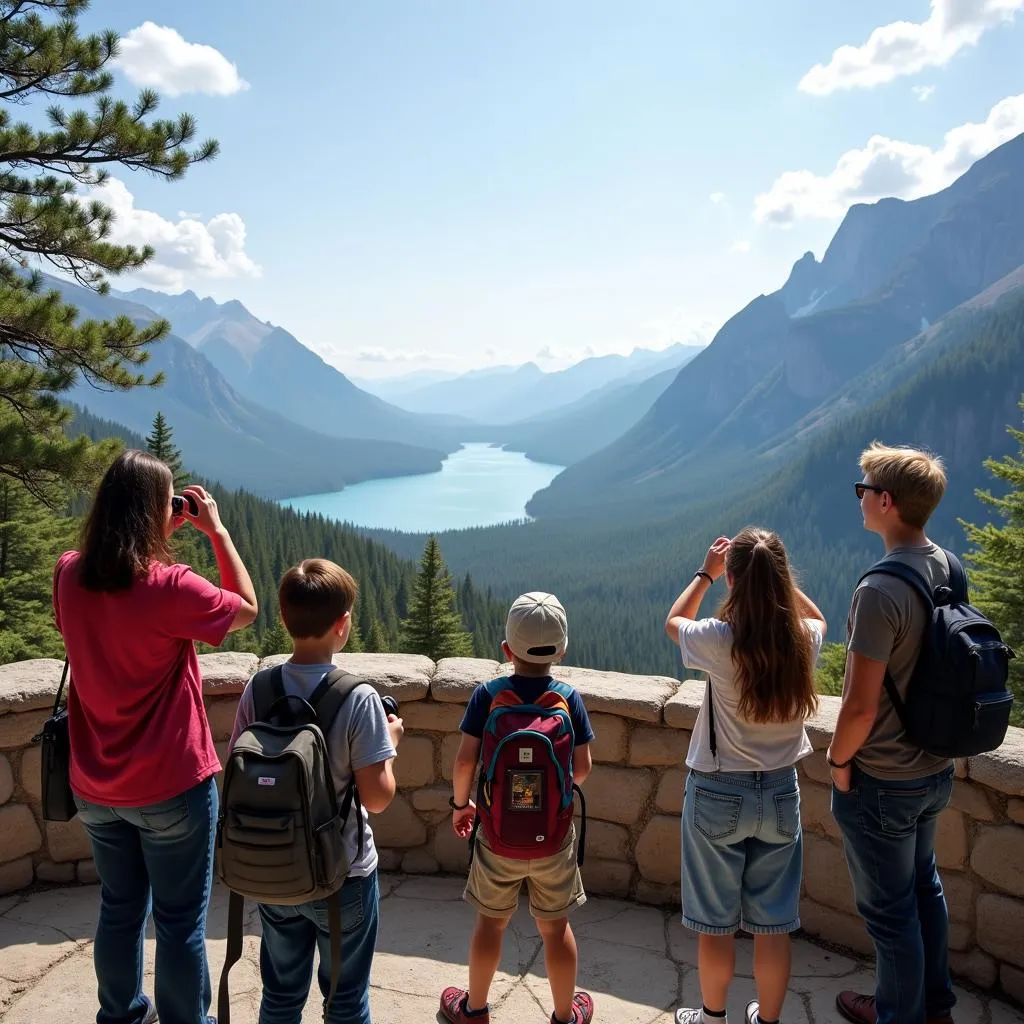The topic of describing a national park you would like to explore is a common theme in IELTS Speaking tests. It allows candidates to showcase their vocabulary, fluency, and ability to express personal preferences while discussing nature and travel. This topic has appeared frequently in past IELTS exams and is likely to remain relevant in future tests. Let’s dive into how to approach this topic effectively across all parts of the IELTS Speaking test.
Nội dung bài viết
- Part 1: Introduction and Interview
- Sample Question 1: Do you enjoy visiting national parks?
- Sample Question 2: What activities do people usually do in national parks?
- Part 2: Long Turn
- Cue Card
- Sample Answer (Band 8-9)
- Follow-up Questions
- Part 3: Two-way Discussion
- Question 1: How do you think national parks contribute to a country’s economy?
- Question 2: Do you think there should be a limit on the number of visitors to national parks? Why or why not?
- Key Vocabulary and Phrases for High Scores
- Examiner’s Advice
Part 1: Introduction and Interview
In this section, the examiner may ask general questions about national parks and nature. Here are some potential questions and sample answers:
Sample Question 1: Do you enjoy visiting national parks?
Band 6-7 Answer:
Yes, I do enjoy visiting national parks. They offer a great opportunity to experience nature and see beautiful landscapes. I find it relaxing to spend time outdoors and away from the city.
Band 8-9 Answer:
Absolutely, I’m quite passionate about exploring national parks. They provide an unparalleled opportunity to immerse oneself in pristine natural environments and witness breathtaking landscapes firsthand. I find the experience not only relaxing but also invigorating, as it allows me to disconnect from the hustle and bustle of urban life and reconnect with nature.
Sample Question 2: What activities do people usually do in national parks?
Band 6-7 Answer:
People usually go hiking, camping, and wildlife watching in national parks. Some also enjoy taking photos of the scenery or having picnics with their families.
Band 8-9 Answer:
National parks offer a diverse range of activities catering to various interests. Avid hikers often tackle challenging trails, while nature enthusiasts engage in wildlife observation and bird watching. Photography aficionados capture the park’s scenic beauty, and families frequently enjoy picnicking or participating in ranger-led educational programs. Additionally, more adventurous visitors might opt for activities like rock climbing, kayaking, or backcountry camping, depending on the park’s specific features and regulations.
Describe a building in your city that stands out can be another interesting topic to explore in your IELTS Speaking practice, as it allows you to discuss architecture and urban landscapes, which can be compared and contrasted with the natural beauty of national parks.
Part 2: Long Turn
Cue Card
Describe a national park you would like to explore.
You should say:
- Where it is located
- What features it is known for
- What activities you can do there
- And explain why you would like to visit this national park
Sample Answer (Band 8-9)
I’d like to talk about Yellowstone National Park, which is a place I’ve always dreamed of exploring. Located primarily in the state of Wyoming in the United States, with parts extending into Montana and Idaho, Yellowstone is renowned for its diverse and awe-inspiring natural wonders.
The park is perhaps most famous for its geothermal features, particularly the Old Faithful geyser, which erupts with remarkable regularity. However, Yellowstone’s allure extends far beyond this iconic attraction. The park boasts a vast array of geological marvels, including colorful hot springs, bubbling mud pots, and steaming fumaroles, all of which create a landscape that seems almost otherworldly.
In addition to its geothermal wonders, Yellowstone is home to an incredible variety of wildlife. Visitors have the opportunity to observe majestic creatures such as bison, elk, grizzly bears, and wolves in their natural habitat. The park’s diverse ecosystems, ranging from lush forests to expansive grasslands, provide a sanctuary for numerous species, making it a paradise for wildlife enthusiasts and photographers alike.
As for activities, the possibilities are truly boundless. Hiking is undoubtedly one of the most popular pursuits, with trails catering to all skill levels, from easy boardwalks around geothermal areas to challenging backcountry routes. Fishing in Yellowstone’s pristine rivers and lakes is another favored activity, as is camping under the stars in one of the park’s many campgrounds. In winter, visitors can enjoy cross-country skiing and snowshoeing, offering a completely different perspective of the park’s beauty.
I’m particularly drawn to Yellowstone because it represents, in my mind, the epitome of natural preservation and biodiversity. The opportunity to witness such a vast and varied landscape, shaped by millions of years of geological activity, is truly once-in-a-lifetime. Moreover, the chance to observe iconic American wildlife in their natural habitat, undisturbed by human development, is incredibly appealing to me as someone deeply interested in ecology and conservation.
Visiting Yellowstone would not only fulfill a longstanding dream but also provide a profound connection with nature that I believe is essential in our increasingly urbanized world. The park’s commitment to balancing conservation with public access is admirable, and I’m eager to experience firsthand how this delicate balance is maintained in one of the world’s most famous national parks.
 Yellowstone National Park's geothermal features
Yellowstone National Park's geothermal features
Follow-up Questions
- What challenges do you think national parks face in preserving their natural environment?
Band 6-7 Answer:
National parks face challenges like too many visitors, pollution, and climate change. These problems can harm plants and animals in the parks. It’s hard for park managers to balance tourism with conservation.
Band 8-9 Answer:
National parks confront a myriad of challenges in their conservation efforts. Overtourism is a significant issue, as the sheer volume of visitors can lead to habitat degradation and disturbance of wildlife. Additionally, parks must grapple with the far-reaching effects of climate change, which can alter ecosystems, impact wildlife migration patterns, and increase the risk of wildfires. Balancing accessibility with preservation is a constant struggle, requiring park authorities to implement stringent management strategies while still allowing the public to enjoy these natural wonders.
- How do you think technology could be used to enhance the experience of visiting a national park?
Band 6-7 Answer:
Technology could be used to make park visits better by providing apps with maps and information about plants and animals. Virtual reality tours could help people see parts of the park they can’t visit in person. Technology could also help track wildlife and protect endangered species.
Band 8-9 Answer:
Technology has the potential to revolutionize the national park experience in numerous ways. Augmented reality applications could offer visitors real-time information about flora, fauna, and geological features as they explore, enhancing educational opportunities. GPS-enabled trail maps and safety alert systems could improve navigation and visitor safety. Furthermore, virtual reality experiences could provide access to remote or fragile areas of parks without physical impact. From a conservation perspective, advanced monitoring technologies and data analytics could aid in wildlife tracking, habitat preservation, and resource management, allowing park authorities to make more informed decisions about conservation strategies.
Describe a time when you helped organize a nature cleanup event is another relevant topic that connects well with the discussion of national parks and environmental conservation.
Part 3: Two-way Discussion
Question 1: How do you think national parks contribute to a country’s economy?
Band 6-7 Answer:
National parks can help a country’s economy by attracting tourists. Visitors spend money on hotels, food, and souvenirs, which creates jobs for local people. Parks also protect natural resources that might be valuable in the future.
Band 8-9 Answer:
National parks make substantial contributions to a country’s economy through various channels. Primarily, they serve as major tourist attractions, driving both domestic and international tourism. This influx of visitors stimulates local economies by creating demand for accommodation, dining, transportation, and other services. Additionally, national parks often foster the development of eco-tourism industries, providing sustainable employment opportunities for local communities.
Beyond direct tourism benefits, national parks play a crucial role in ecosystem services. They protect watersheds, which are vital for water supply to urban areas and agriculture. The biodiversity preserved within these parks can be a source of scientific research and potential medical discoveries, which can have significant economic value. Furthermore, the mere existence of these protected areas can enhance a country’s international image, potentially attracting foreign investment and boosting other sectors of the economy indirectly.
Question 2: Do you think there should be a limit on the number of visitors to national parks? Why or why not?
Band 6-7 Answer:
Yes, I think there should be a limit on visitors to national parks. Too many people can damage the environment and disturb wildlife. It’s important to protect nature for future generations. However, limiting visitors might make it harder for some people to enjoy nature.
Band 8-9 Answer:
The question of limiting visitors to national parks is a complex and nuanced issue. On one hand, implementing visitor caps can be crucial for environmental preservation. Excessive foot traffic can lead to soil erosion, habitat destruction, and wildlife disturbance. Overcrowding can also diminish the visitor experience, detracting from the sense of solitude and connection with nature that many seek in these spaces.
Conversely, limiting access raises concerns about equity and public right to these natural heritage sites. National parks are often considered public treasures, and restricting visitation could be seen as contradicting their fundamental purpose of making nature accessible to all.
A balanced approach might involve implementing dynamic management strategies. This could include seasonal visitor caps during peak periods, timed entry systems, or promoting visits to less popular areas of parks. Additionally, educating visitors about responsible tourism and implementing stricter regulations on behavior within parks could help mitigate the negative impacts of high visitation without necessarily reducing overall numbers.
Ultimately, the goal should be to strike a balance between preservation and access, ensuring that these natural wonders remain intact for future generations while still fulfilling their role as spaces for public enjoyment and education.
 National park visitors enjoying a scenic view
National park visitors enjoying a scenic view
Key Vocabulary and Phrases for High Scores
-
Biodiversity /ˌbaɪəʊdaɪˈvɜːsəti/ (noun): The variety of plant and animal life in a particular habitat.
Example: Yellowstone National Park is renowned for its incredible biodiversity. -
Ecosystem /ˈiːkəʊˌsɪstəm/ (noun): A biological community of interacting organisms and their physical environment.
Example: The park’s diverse ecosystems support a wide range of flora and fauna. -
Conservation /ˌkɒnsəˈveɪʃn/ (noun): The protection of plants, animals, and natural areas.
Example: The national park plays a crucial role in wildlife conservation efforts. -
Pristine /ˈprɪstiːn/ (adjective): In its original condition; unspoiled.
Example: The park’s pristine lakes are a testament to effective environmental management. -
Sustainable tourism /səˈsteɪnəbl ˈtʊərɪzəm/ (noun phrase): Tourism that respects both local people and the traveler, cultural heritage and the environment.
Example: The park authorities are promoting sustainable tourism practices to minimize environmental impact.
Describe a place in nature where you would like to camp is another topic that can help you practice using this nature-related vocabulary in context.
Examiner’s Advice
To achieve a high score in the IELTS Speaking test when discussing national parks or similar topics:
-
Use a wide range of vocabulary related to nature, conservation, and tourism. Include specific terms relevant to the park you’re describing.
-
Demonstrate critical thinking by discussing both the benefits and challenges associated with national parks and tourism.
-
Provide detailed examples to support your points, drawing from personal experiences or knowledge about specific national parks.
-
Use a variety of grammatical structures, including complex sentences, to articulate your ideas clearly and coherently.
-
Show awareness of global issues related to conservation and sustainable tourism in your responses.
-
Practice speaking fluently about nature and travel topics, focusing on maintaining a natural pace and intonation.
-
Develop your ideas fully, especially in Part 2 and Part 3, to showcase your ability to speak at length on the topic.
Remember, the key to success in the IELTS Speaking test is not just about what you say, but how you say it. Aim for clarity, fluency, and depth in your responses.
Describe a place where you experienced nature up close can be an excellent topic to practice these skills, allowing you to draw parallels with the national park discussion while focusing on personal experiences.


